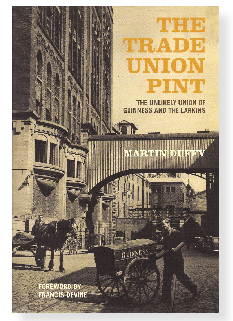Martin Duffy
(Liberties Press, €17.99)
ISBN 9781907593468
 This book chronicles how the general workers in Guinness’s brewery became unionised and ended up as members of Larkin’s Workers Union of Ireland (WUI). It tells this story through looking at the career of Jack Carruthers, a brewery labourer and later the full-time WUI branch secretary. Carruthers was one of the new intake employed after 1945 who had gained military experience in the Irish forces or in the British forces (as had Paddy Cardiff and Jack Harte). On the other side, it examines the career of Sir Charles Harvey, who on retiring from British military service in 1946 took up duties as assistant general manager of the Dublin brewery with responsibility for personnel.
This book chronicles how the general workers in Guinness’s brewery became unionised and ended up as members of Larkin’s Workers Union of Ireland (WUI). It tells this story through looking at the career of Jack Carruthers, a brewery labourer and later the full-time WUI branch secretary. Carruthers was one of the new intake employed after 1945 who had gained military experience in the Irish forces or in the British forces (as had Paddy Cardiff and Jack Harte). On the other side, it examines the career of Sir Charles Harvey, who on retiring from British military service in 1946 took up duties as assistant general manager of the Dublin brewery with responsibility for personnel.
The brewery had an ambiguous relationship with unions—the craft unions that functioned there ranged from Dublin’s oldest, the regular Dublin Operative Coopers’ Society (still functioning in the 1980s), to the newer unions of the nineteenth century, such as the engineers and the boilermakers. The brewery, however, escaped the waves of unionisation that swept Dublin’s unskilled in the 1890s and the first decade of the twentieth century. The author states that ‘It was thought that there would never be a union in Guinness as the workers wanted for nothing’. It was not until after World War II that Guinness general workers unionised, with post-war inflation, the establishment of the Labour Court and the establishment of a house association being key factors.
Francis Devine provides an excellent foreword, setting the context and describing the disproportionately large contribution of the Guinness branch to the internal life of the WUI. Regrettably, the book contains neither index nor references—a fault that will limit its use by students, which is a pity, given the value of the work. The sources used are in the Guinness archives, the Irish Labour History Society (ILHS) archives and material in possession of the Carruthers family, but again the lack of references disguises the amount of research that was undertaken.
In the years after World War II rapid inflation put an upward pressure on wages and this played out in a particular way for Guinness, as they sought to maintain their position as one of Dublin’s premium employers. The first attempts at organising the general labour force was through the founding of a staff association. Arguably this would have remained the case had not the brewery management treated the association with utter contempt, stringing them along ad infinitum. The failure of the association caused some activists to seek a union and they interviewed both the WUI in the person of Jim Larkin Jr and the ITGWU in the person of Frank Robbins.
What does this work tell us about the process of union organisation—an issue of current relevance? It shows the importance of having an active committee on the inside of an enterprise, true then as now. However, the paternalism of Guinness, and the noblesse oblige of their managers, knows no parallel in today’s world of ‘human resource management/industrial relations’. Indeed, the company attended the Labour Court hearing in February 1948 when the brewery association sought recognition. The association made the point in its submission that ‘Guinness already deals with the unions to which the tradesmen belong’.
The book raises issues for the study of labour history, for which 2013 marks a double anniversary, being the 50th anniversary of the first publication of E.P. Thompson’s masterpiece The making of the English working class and the 100th anniversary of the Lockout. Thompson’s approach typified the broadening out of labour history from the history of unions as institutions to a history of unions seen through the prism of their members’ working lives. The history of union institutions on their own can be flat and monochrome. This is not surprising, as unions by definition are institutions of the workplace and a historical approach that emphasises the institution at the expense of the labour process will, at best, tell only half the story. There are examples of works which take a more broadly based approach, such as Charlie Callan’s Painters in union and Hywel Francis’s South Wales miners, or indeed John Swift’s History of the Dublin bakers. All these authors had an intimate knowledge of the industries they describe. This broad definition of labour has been adopted by the editors of Saothar since its inception.
The criticism of institutional history can also be levelled at business historians, who in many cases labour away in blissful ignorance of union records, which in many cases are capable of providing an alternative view of the running of the enterprise to that presented to the board. The book paints a succinct and valuable pen-picture of the corporate culture prevailing at senior management levels. The culture of ‘officers and gentlemen’ who often partook of long lunches was then in its twilight years, as management of civilian organisations became a discipline in its own right.
The trade union pint is a valuable addition to Irish labour history, dealing with one of the country’s major employers. The book also gives a view on the business and technological challenges facing the brewery in the two decades after 1945. HI
Peter Rigney is an industrial officer with the Irish Congress of Trade Unions.

